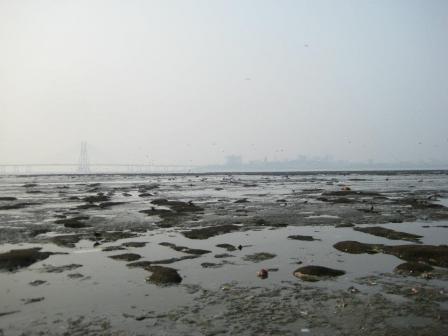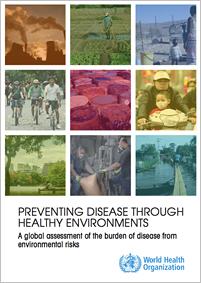EPA's Collaboration with the World Health Organization (WHO)

Environmental factors have a major effect on human health. In fact, a 2012 WHO Study found that modifiable environmental factors are responsible for 23% of deaths and 26% of global deaths among children under five.
EPA has a longstanding program of cooperation with the World Health Organization (WHO) to address the direct link between protecting public health and supporting a clean environment. EPA’s mission, to protect human health and the environment in the United States, naturally aligns with WHO’s goal to build a better, healthier future for all people.
Visit the official website of the World Health Organization. Exit
EPA-WHO Agreement
September 2016: The EPA-WHO Memorandum of Understanding (MOU), renewed in September 2016, outlines topics for mutual cooperation, including:
- Indoor and Outdoor Air Quality and Health
- Climate Change and Health
- Water, Sanitation, and Health
- Toxic Chemicals, Pesticides, and Risk Assessment
- Children’s Environmental Health, Urban Environmental Health, and other multimedia areas of investigations
- Methods, tools and information products to support decision-making relating to Environmental and Public Health
Our first MOU with WHO was signed at the 1992 Rio de Janeiro Earth Summit.
2016 Preventing Disease through Healthy Environments Report Released
March 2016: EPA welcomed the WHO report Preventing Disease Through Healthy Environments: a global assessment of the burden of disease from environmental risks, Exit which concluded that 12.6 million (23% of all) global deaths are caused by environmental factors under human control. These "modifiable environmental factors" are responsible for:
- 35% of lower respiratory diseases
- 57% of diarrheal diseases
- 20% of cancers
- 44% of asthma
The report also found that the health of children (especially children under five years of age, and to a lesser extent up to age 10) and older adults (between 50 and 75 years of age) is most affected by environmental factors. Since 2002 there has been a significant shift from infectious, parasitic, and nutritional diseases to noncommunicable diseases, primarily due to a decline of infectious disease rates and reduction in environmental risks causing infectious diseases (e.g. a higher share of people having access to safe water and sanitation).
These proven health and environment connections reinforce the importance of EPA's mission to protect human health and the environment, and the need for close partnership with the public health community.
About WHO
As the coordinator of international health for the United Nations, WHO produces public health guidelines and standards, supports health research, and helps countries address public health issues. WHO works with governments and partners through offices in more than 150 countries. WHO work includes:
- Health Systems
- Noncommunicable diseases
- Promoting health through the life-course
- Communicable diseases
- Preparedness, surveillance and response
WHO’s 194 member states appoint delegates to attend the World Health Assembly, the legislative and supreme body of WHO. The agenda for World Health Assembly meetings is set by an executive board, which has 34 members elected for three year terms. WHO also has six regional offices for Africa, the Americas, South-East Asia, Europe, the Eastern Mediterranean, and the Western Pacific.
EPA @ WHO
EPA and WHO cooperate on a wide range of environmental and public health issues, including those associated with air quality and climate, toxic chemicals and pesticides, and water and sanitation. We also work with WHO on shared efforts to assess risk, to understand how environmental factors contribute to disease, and to develop WHO guidelines for environmental standards (e.g. for air and drinking water quality).
EPA’s activities with WHO are advanced under both a Memorandum of Understanding and a Cooperative Agreement with WHO. Specific areas of work include:
Environmental Burden of Disease:
EPA supports WHO efforts to quantify disease caused by environmental factors. In 2006, WHO produced the first global estimates of the loss of quality years of life as a result of exposures to lead, indoor smoke from solid fuels, outdoor air pollution, water, sanitation and hygiene, and climate change. EPA and WHO are currently working to compile data and analyze how environmental factors contribute to diseases levels at the country level.
- View: Global estimates of burden of disease caused by the environment and occupational risks (WHO) Exit
Climate Change and Human Health
Climate change negatively impacts human health, through increased heat-related mortality and sickness, worsened air quality, and more rapid spread of vector-, water- and food-borne diseases, particularly among vulnerable populations. EPA is collaborating with the WHO and others to promote the importance of taking health risks associated with the changing climate into account in the development of policy responses and programs.
Indoor and Outdoor Air Quality and Health
 EPA works with WHO to address the health effects of pollution to air, water and land.
EPA works with WHO to address the health effects of pollution to air, water and land. EPA works with WHO to support reductions in air pollution generated in developing countries, which has the potential to travel across country boundaries. EPA and WHO collaborate to create country plans to address indoor air pollution, primarily focusing on promoting cleaner methods of cooking, heating and lighting. WHO may hold regional and country workshops to help implement the actions identified in these science based plans.
EPA also provides ongoing technical expertise to help revise WHO’s guidelines for outdoor air pollution and disseminate information on effective interventions to improve outdoor air quality. This collaboration includes updating WHO’s air quality guidelines, which are used by countries around the world to implement their air quality programs.
EPA also provided expert review of WHO’s International Radon Project, Exit which recommended measures building professionals can use to reduce health risks from radon exposure. This project included the development of training material which has informed national radon reduction programs around the world. EPA and WHO are now building on that work by creating a database of radon regulations, and by maintaining an online platform to support technical and communications experts to share effective radon interventions.
Children’s Environmental Heath
EPA and WHO contributed to the development of a global initiative on Children’s Environmental Health Indicators, Exit to increase international cooperation, improve assessment of children’s environment health, and monitor the success or failure of interventions. While the state of children's environmental health has improved dramatically in the United States, this is still a topic of importance to American families. The resulting training package for health care providers on children’s environmental health Exit is now available on the WHO website.
Chemicals and Toxics
EPA currently serves as the Advisory Group Chair of the Global Alliance to Eliminate Lead Paint (Lead Paint Alliance), led by a joint secretariat of WHO and the United Nations Environment Programme. The Lead Paint Alliance is working to promote lead paint laws worldwide by 2020 to eliminate the use of lead paint, including household paint and paint used on children’s toys.
EPA helped create WHO’s Chemical Risk Assessment Network, Exit launched in 2012. This network has improved global chemical risk assessment though scientific exchanges, capacity building, and identification of research needs and emerging health risks. EPA and WHO continue to create standardized methodologies to evaluate chemicals and train experts in these methods.
Water, Sanitation and Health
 EPA works with WHO to promote clean water and sanitation for better global health.
EPA works with WHO to promote clean water and sanitation for better global health.EPA has long supported WHO’s guidelines on drinking water quality. Exit At present, EPA and WHO are expanding the guidelines to address chemical exposure in drinking water, a critical element of ensuring safe water for human consumption.
EPA and WHO developed guidelines for Sanitation Safety Planning Exit to support the safe reuse of wastewater and greywater in agriculture, improve waste management and better protect water quality. These guidelines will support water suppliers, governments and other stakeholders.
Useful Links
The following links exit the site Exit
- World Health Organization (WHO)
- Preventing Disease through Health Environments: A Global Assessment of the Burden of Environmental Risks
- WHO Information on Air Pollution
- WHO Global Plan of Action for Children's Health and the Environment
- WHO Guidelines for Drinking-Water Quality
- WHO Information the Global Alliance to Eliminate Lead Paint
- WHO International Programme on Chemical Safety
- WHO Information on Sanitation Safety Planning
- WHO Information on Radon
Explore all of EPA's work with International Organizations

